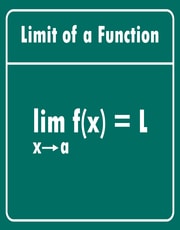Limits in Calculus | Definition and Rules with Examples
In mathematics, limits are used to solve the complex calculus problems of various functions. It is mainly used to define differential, continuity, and integrals. Limits accomplished a particular value function by substituting the limit value.
Limits are very essential in a type of antiderivative known as definite integral in which upper and lower limits are applied. In this post, we’ll learn the definition and rules of limits with a lot of examples.
What are the limits in calculus?
In calculus, a value that a function approaches as an input of that function gets closer and closer to some specific number is known as limit. In other words, when a function approaches to some value to evaluate the value of limit of that function is known as limits.
To measure the nearness and representation of mathematical concept ideas, the limit’s notation can be used. It is very beneficial for defining other branches of calculus like derivative, continuity, and antiderivative. Students often find these topics challenging at first, which is why many turn to online math tutoring for clear explanations and guided practice.
The equation of limits
The formula or equation used to calculate the limits of the functions is given below.
limx→u h(x) = N
- Lim is the notation of limits.
- u is the limit value of the function.
- h(x) is the given function.
- x is the variable of the function.
- N is the result of the function after applying the limit value u.
You have to apply the limit value u to the given function h(x), for solving the problems of limits. The limits are not applied on the constant functions so the limits of constant functions remain unchanged.
Rules of limits
There are various rules of limits in calculus. Let’s discuss them briefly with the help of examples to evaluate the limit problems.
1. Constant rule
According to this rule of limits, the constant function remains the same. Because limits are applied only on the variables. The equation for the constant rule is:
limx→u C = C
- Lim is the notation of limits.
- u is the limit value of the function.
- C is the given function.
Example
Find the limit of 56 as x approaches to 5.
Solution
Step 1: Apply the limit notation on the given function.
limx→5 56
Step 2: Now apply the limit.
limx→5 56 = 56 (by constant rule)
2. Constant function rule
According to this rule of limits, the constant with the function will be written outside the limit notation. Because limits are applied only on the variables. The equation for the constant function rule is:
limx→u C h(x) = C * N
- Lim is the notation of limits.
- u is the limit value of the function.
- C is any constant.
- h(x) is the given function.
- x is the variable of the function.
- N is the result of the function after applying the limit value u.
Example
Find the limit of 23x3 as x approaches to 7.
Solution
Step 1: Apply the limit notation on the given function.
limx→7 23x3
Step 2: Now apply the constant function rule of limit.
limx→7 23x3 = 23 limx→7 x3
Step 3: Now apply the limit.
limx→7 23x3 = 23 (73)
limx→7 23x3 = 23 (7 * 7 * 7)
limx→7 23x3 = 23 (343)
limx→7 23x3 = 7889
3. Sum rule
According to this rule of limits, the notation applied to each function separately. The equation for the sum rule is:
limx→u [h(x) + g(x)] = limx→u (h(x)) + limx→u (g(x)) = M + N
- Lim is the notation of limits.
- u is the limit value of the function.
- g(x) & h(x) are the given functions.
- x is the variable of the function.
- M & N are the results of the functions after applying the limit value u.
Example
Find the limits of x3 + x5 as x approaches to 3.
Solution
Step 1: Apply the limit notation on the given function.
limx→3 [x3 + x5]
Step 2: Now apply the sum rule of limit.
limx→3 [x3 + x5] = limx→3 (x3) + (x5)
Step 3: Now apply the limit.
limx→3 [x3 + x5] = (33) + (35)
limx→3 [x3 + x5] = (3 * 3 * 3) + (3 * 3 * 3 * 3 * 3)
limx→3 [x3 + x5] = (27) + (243)
limx→3 [x3 + x5] = 270
4. Difference rule
According to this rule of limits, the notation applied to each function separately. The equation for the difference rule is:
limx→u [h(x) – g(x)] = limx→u (h(x)) – limx→u (g(x)) = M – N
- Lim is the notation of limits.
- u is the limit value of the function.
- g(x) & h(x) are the given functions.
- x is the variable of the function.
- M & N are the results of the functions after applying the limit value u.
Example
Find the limits of x3 – x5 as x approaches to 2.
Solution
Step 1: Apply the limit notation on the given function.
limx→2 [x3 – x5]
Step 2: Now apply the difference rule of limit.
limx→2 [x3 – x5] = limx→2 (x3) + limx→2 (x5)
Step 3: Now apply the limit.
limx→2 [x3 – x5] = (23) – (25)
limx→2 [x3 – x5] = (2 * 2 * 2) – (2 * 2 * 2 * 2 * 2)
limx→2 [x3 – x5] = (8) – (32)
limx→2 [x3 – x5] = -24
5. Product rule
According to this rule of limits, the notation applied to each function separately. The equation for the product rule is:
limx→u [h(x) * g(x)] = limx→u (h(x)) * limx→u (g(x)) = M * N
- Lim is the notation of limits.
- u is the limit value of the function.
- g(x) & h(x) are the given functions.
- x is the variable of the function.
- M & N are the results of the functions after applying the limit value u.
Example
Find the limits of x5 * x3 as x approaches to 4.
Solution
Step 1: Apply the limit notation on the given function.
limx→4 [x5 * x3]
Step 2: Now apply the product rule of limit.
limx→4 [x5 * x3] = limx→4 (x5) * limx→4 (x3)
Step 3: Now apply the limit.
limx→4 [x5 * x3] = (45) * (43)
limx→4 [x5 * x3] = (4 * 4 * 4 * 4 * 4) * (4 * 4 * 4)
limx→4 [x5 * x3] = (1024) * (64)
limx→4 [x5 * x3] = 65536
6. L’hospital rule
According to this rule, if the function forms 0 by 0 or infinity by infinity form after applying the limits then take the derivatives of the numerator and the denominator and then apply the limit value again.
Example
Find the limit of x2 – 4 / 4x – 2x2 as x approaches to 2.
Solution
Step 1: Apply the limit notation on the given function.
limx→2 [x2 – 4 / 4x – 2x2]
Step 2: Now apply the quotient rule of limit and apply the limit value.
limx→2 [x2 – 4 / 4x – 2x2] = limx→2 [x2 – 4] / limx→2 [4x – 2x2]
limx→2 [x2 – 4 / 4x – 2x2] = [22 – 4] / [4(2) – 2(2)2]
limx→2 [x2 – 4 / 4x – 2x2] = [4 – 4] / [4(2) – 2(4)]
limx→2 [x2 – 4 / 4x – 2x2] = [4 – 4] / [8 – 8]
limx→2 [x2 – 4 / 4x – 2x2] = 0 / 0
Step 3: As the functions make zero by zero form by applying the limit value, so apply the L’hospital rule and apply the limit value again.
limx→2 [x2 – 4 / 4x – 2x2] = limx→2 [d/dx (x2 – 4) / d/dx (4x – 2x2)]
limx→2 [x2 – 4 / 4x – 2x2] = limx→2 [2x – 0 / (4 – 4x)]
limx→2 [x2 – 4 / 4x – 2x2] = limx→2 [2x / (4 – 4x)]
limx→2 [x2 – 4 / 4x – 2x2] = [2(2) / (4 – 4(2))]
limx→2 [x2 – 4 / 4x – 2x2] = [4 / (4 – 8)]
limx→2 [x2 – 4 / 4x – 2x2] = [4 / (– 4)]
limx→2 [x2 – 4 / 4x – 2x2] = -1
Summary
In this post, we have learned the definition and rules of limits with a lot of examples. Now you can grab all the basics of limits just by following the rules of this post.
Explore These Additional Math Resources (Parents, Teachers and Students)






